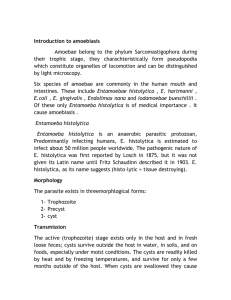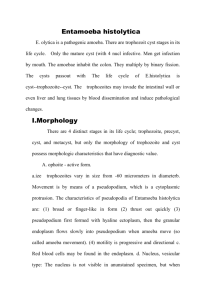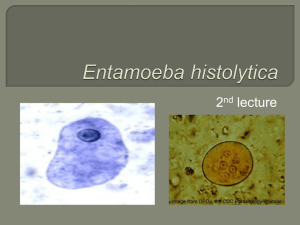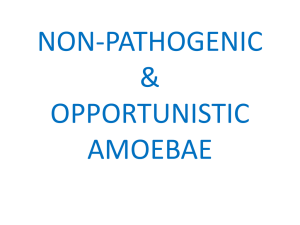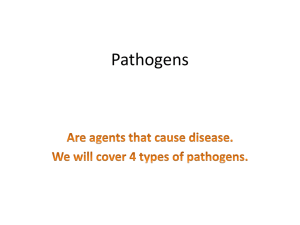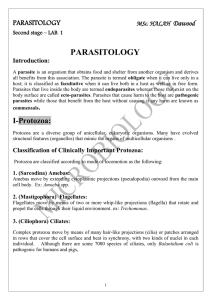محاضره 2
advertisement
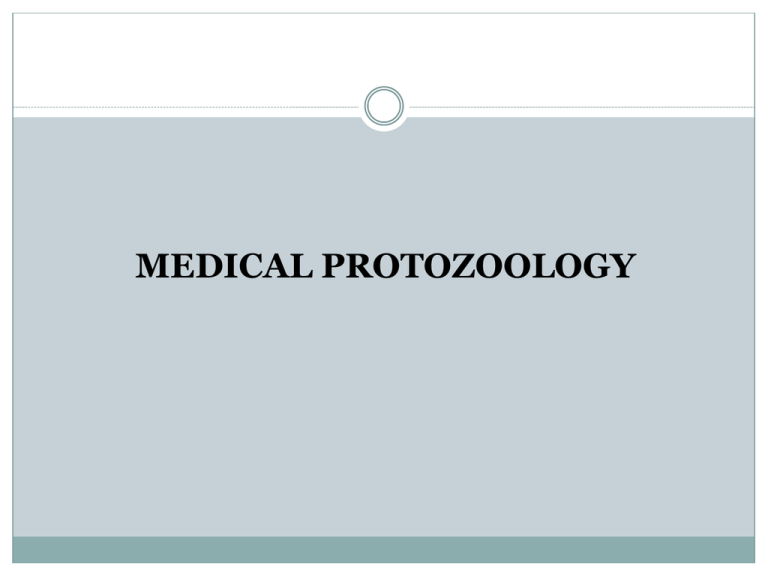
MEDICAL PROTOZOOLOGY Protozoa (singular, protozoan), from the Greek ‘protos’ and ‘zoon’ meaning “first animal” are members of eukaryotic protists. They may be distinguished from other eukaryotic protists by their ability to move at some stage of their life cycle and by their lack of cell wall. Occurrence of protozoa Protozoa are found in all moist habitats. They are common in sea, in soil and in fresh water. These organisms occur generally as a single cell. Colonies of protozoa might also occur in which individual cells are joined by cytoplasmic threads and form aggregates of independent cells. However, distinct types of protozoa, include a resistant cyst (non-motile) stage to survive adverse environmental conditions, such as desiccation, low nutrient supply, and even anaerobiosis. Morphology of protozoa Protozoa are predominantly microscopic, ranging in size from 2 to more than 100μm. Morphologically, they are within a mass of protoplasm, consisting of a true membrane – bound nucleus and cytoplasm. Importance of protozoa Protozoa serve as an important link in the food chain and ecological balance of many communities in wetland & aquatic environments. They are also important in biological sewage treatment, which involves both anaerobic digestion and/or aeration. Medical concern of protozoa Protozoa are ubiquitous in moist areas, including the human alimentary canal. From an ecological standpoint, protozoa may be divided into free-living forms and symbiotic forms. Some of the symbiotic ones are parasitic and may cause disease. Although most amoebas are free-living, several are found as commensal inhabitants of the intestinal tract in humans. One of these organisms Entamoeba histolytica may invade tissue and produce disease. The majority of ciliates are free living and seldom parasitize humans. Flagellates of the genus Trypanosomes and Leishmania are capable of invading the blood & tissue of humans, where they produce severe chronic illness. Others such as Trichomonas vaginalis and Giardia lamblia, inhabit the urogenital and gastrointestinal tracts and initiate disease characterized by mild to moderate morbidity but no mortality. Sporozoan organisms, in contrast, produce two of the most potentially lethal diseases of humankind: malaria and toxoplasmosis. Reproduction and regeneration of protozoa As a general rule, protozoa multiply by asexual reproduction. This is not to say that sexual processes are absent in the protozoa. Some parasitic forms may have an asexual phase in one host and a sexual phase in another host. Transmission In most parasitic protozoa, the developmental stages are often transmitted from one host to another within a cyst. The reproduction process is also related to the formation of the cyst. Asexual reproduction of some ciliates and flagellates is associated with cyst formation, and sexual reproduction of Sporozoa invariably results in a cyst. Pathogenic protozoa can spread from one infected person to another by: • Faecal – oral transmission of contaminated foods and water. • Insect bit inoculums or rubbing infected insect faeces on the site of bite. • Sexual intercourse Pathogenesis Protozoan organisms are virtually always acquired from an exogenous source, and as such, they have evolved numerous ways to enter the body of the human host. Factors that are important for pathogenicity include: • Attachment to the host tissue followed by replication to establish colonization. • Toxic products released by parasitic protozoa • Shifting of antigenic expression to evade the immune response and inactivate host defences. Antiprotozoal agents Generally the antiprotozoal agents target relatively rapidly proliferating, young, growing cells of the parasite. Most commonly, these agents target nucleic acid synthesis, protein synthesis, or specific metabolic pathways (e.g. folate metabolism) unique to the protozoan parasites. CLASSIFICATION OF PROTOZOA Protozoa of medical importance are classified based on their morphology and locomotive system as described below: Amoebas - Entamoeba histolytica Flagellates - Giardia lamblia, Trichomonas vaginalis, Trypanosoma spp, Leishmania spp. Cliliophora - Balantidium coli Coccidian - Isospora belli, Cryptosporidium parvum, Toxoplasma gondii, Plasmodium species Protozoan pathogens can also be grouped according to the location in the body where they most frequently cause disease. AMOEBIASIS INTRODUCTION Amoebas primitive unicellular microorganisms with a relatively simple life cycle which can be divided into two stages: Trophozoite – actively motile feeding stage. Cyst – quiescent, resistant, infective stage. Their reproduction is through binary fission, or through the development of numerous trophozoites within the mature multinucleated cyst. Motility is accomplished by extension of pseudopodia (“false foot”) 1.1. Entamoeba histolytica Morphological features: 1.1. Entamoeba histolytica (a) Trophozoites: Trophozoites vary in size from about 10-60μm in diameter. Motility is rapid, progressive, and unidirectional, through pseudopods. The cytoplasm is usually described as finely granular with few ingested bacteria or debris in vacuoles. In the case of dysentery, however, RBCs may be visible in the cytoplasm, and this feature is diagnostic for E. histolytica. 1.1. Entamoeba histolytica (b) Cyst Cysts range in size from 10-20μm. The immature cyst has inclusions namely; glycogen mass and chromatoidal bars. As the cyst matures, the glycogen completely disappears; the chromotiodals may also be absent in the mature cyst. life cycle of Entamoeba histolytica Life cycle Intestinal infections occur through the ingestion of infective cyst, contaminated food or drink and also by hand to mouth contact. It is then passed unaltered through the stomach, as the cyst wall is resistant to gastric juice. In terminal ileum (with alkaline pH), Trophozoites being actively motile invade the tissues and ultimately lodge in the submucous layer of the large bowel. Here they grow and multiply by binary fission. Life cycle Trophozoites are responsible for producing lesions in amoebiasis. Invasion of blood vessels leads to secondary extra intestinal lesions. A certain number of trophozoites come from tissues into lumen of bowel and are first transformed into pre-cyst forms. Eventually, mature cysts form. These are the infective forms. Immature cysts can mature in external environments and become infective. Pathogenesis Trophozoites divide and produce extensive local necrosis in the large intestine. Invasion into the deeper mucosa with extension into the peritoneal cavity may occur. This can lead to secondary involvement of other organs, primarily the liver but also the lungs, brain, and heart. Extraintestinal amoebiasis is associated with trophozoites. Amoebas multiply rapidly in an anaerobic environment, because the trophozoites are killed by ambient oxygen concentration. Epidemiology E. histolytica has a worldwide distribution. Although it is found in cold areas, the incidence is highest in tropical and subtropical regions that have poor sanitation and contaminated water. About 90% of infections are asymptomatic, and the remaining produces a spectrum of clinical syndrome. Patients infected with E. histolytica pass noninfectious trophozoites and infectious cysts in their stools. Therefore, the main source of water and food contamination is the symptomatic carrier who passes cysts. Symptomatic amoebiasis is usually sporadic. The epidemic form is a result of direct person-to-person Faecal-oral spread under conditions of poor personal hygiene. Clinical features The outcome of infection may result in a carrier state, intestinal amoebiasis, or exteraintestinal amoebiasis. Diarrhea, flatulence, and cramping are complaints of symptomatic patients. More severe disease is characterized by the passing of numerous bloody stools in a day. Systemic signs of infection (fever, leukocytosis, rigors) are present in patients with exteraintestinal amoebiasis. Laboratory diagnosis In intestinal amoebiasis: Examination of a fresh dysenteric faecal specimen or rectal scraping for trophozoite stage. Motile amoebae containing red cells are diagnostic of amoebic dysentery. Examination of formed or semi formed faeces for cyst stage. Cysts indicate infection with either a pathogenic E. histolytica or non-pathogenic E.dispar. Treatment Acute, fulminating amoebiasis is treated with metronidazole followed by iodoquinol, and asymptomatic carriage can be eradicated with iodoquinol, diloxanide furoate, or paromomycin. The cysticidal agents are commonly recommended for asymptomatic carriers who handle food for public use. Prevention Introduction of adequate sanitation measures and education about the routes of transmission. Avoid eating raw vegetables grown by sewerage irrigation and night soil OTHER AMEBAE INHABITING THE ALIMENTARY CANAL 1- Entamoeba hartmanni in all of its life–cycle stage, E.hartmanni resembles E.histolytica except in size. • Infection is acquired by ingestion of food or water contaminated with cyst-bearing faeces. 2- Entamoeba coli 4- Endolimax nana 3- Entamoeba polecki THANK YOU
